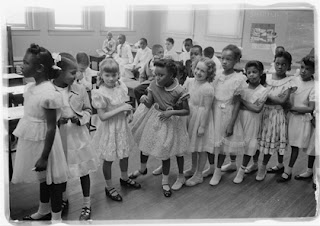 |
| Students at the Barnard School, Washington DC, 1955 |
One thing that we used to learn
young is that there is never something for nothing. That axiom appears to be on
the wane. At least one state plans to give away academic achievement.
Imagine that you work at a jewelry
factory on a line that produces earrings. You are paid by the piece and are
expected to complete 10 sets per hour. You are pretty good at your job and
regularly meet or exceed your quota. You are proud of your performance and feel
that you earn every penny of your paycheck.
Suddenly, one day, your manager
approaches and asks to speak privately. Upon discovering that you are of
Lithuanian ancestry, she confides that you are no longer to be held to the same
standard as your peers. Instead of the 10 pieces per hour expected of your
coworkers, you will only be required to complete five (although you will be
paid the same).
How will you react? How do you
feel? Relieved, because ten sets per hour was demanding and now you can coast?
Or ashamed, because you will now take it easy while your coworkers continue to
produce at the higher level? The answer might well be the latter since you were
deemed not capable due only to your Lithuanian ancestry. What’s wrong with
being Lithuanian, anyway?
A poor analogy, perhaps, but
something quite similar is about to happen in Virginia. The state board of
education, upon receiving a federal waiver from the “No Child Left Behind” act,
is adjusting expectations for students based on their ancestry.
According to Virginia Public Radio,
this is the scoop. “Here's what the Virginia state board of education actually
did. It looked at students' test scores in reading and math and then proposed
new passing rates. In math it set an acceptable passing rate at 82 percent for
Asian students, 68 percent for whites, 52 percent for Latinos, 45 percent for
blacks and 33 percent for kids with disabilities.”
So now, depending on your ancestry,
you will be held to different levels of expectation and standards of success.
An African American student is expected to achieve only roughly half of an
Asian American. What kind of message is that to send to striving students? How
is that expected to motivate and cheer them on to succeed? And how will they
fare in college, once graduated from high school under this tiered
multi-ancestral success scheme?
Another approach is to believe that
all students are capable of great achievement if only they are nurtured and
encouraged. Students who are believed in and presented with high expectations
can achieve great results. Lowering the standards of success is cruel and
destructive. It is far better to cultivate and raise each individual student to
their greatest human potential.
One thing is clear - this policy benefits only adults. The teachers and their unions, by redefining failure as success, have mitigated their own failures. And bureaucrats also come out on top - they no longer have to focus energy on the problem because, poof, they have made the problem vanish. The only faction accruing absolutely no benefit - the children.
Lowering expectations unavoidably leads to the diminution of human dignity. How can we possibly do that with a clear conscience?

